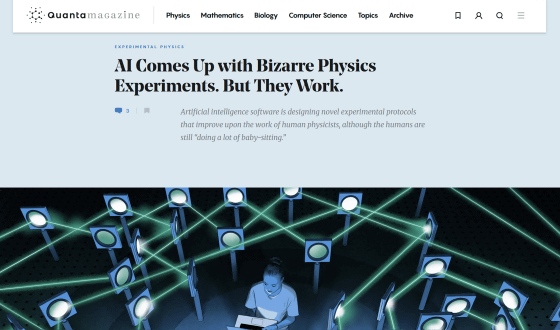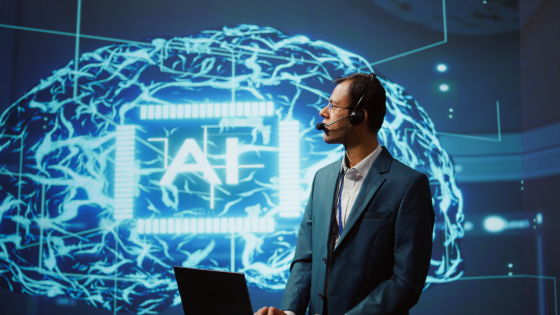AI has also become a powerful tool in the field of physics, proving useful for devising new experimental equipment and finding patterns in data.

In recent years, attempts to apply AI to scientific research have been progressing, with Google
AI Comes Up with Bizarre Physics Experiments. But They Work. | Quanta Magazine
https://www.quantamagazine.org/ai-comes-up-with-bizarre-physics-experiments-but-they-work-20250721/

The Laser Interferometer Gravitational-Wave Observatory (LIGO) is a huge experimental facility to detect gravitational waves proposed by Albert Einstein. The two gravitational wave detectors installed at the Hanford Site in Washington State and Livingston , Louisiana in the United States send laser beams back and forth through a huge, L-shaped, ultra-high vacuum system with a total length of 4 km to detect the slightest signs of gravitational waves.
Physicists spent decades designing LIGO, and more than 20 years after construction began, LIGO finally succeeded in detecting gravitational waves emitted by the merger of two black holes in 2015. However, in the mid-2000s, Professor Rana Adhikari of California Institute of Technology, who helped improve the design of LIGO, came up with the idea of improving LIGO to detect gravitational waves over a wider frequency range.
To consider how to improve LIGO, Radikari and his team turned to an AI platform developed for designing physics experiments, which gave the AI any and all parts and devices that could be combined to build an arbitrarily complex gravitational wave detector, without any constraints.
The AI then designed a gravitational wave detector hundreds of kilometers long, consisting of thousands of components such as lenses, mirrors, and lasers. 'The output of the AI was completely incomprehensible to humans. It was so complex that it looked like an alien or an AI. There was no symmetry or beauty to it, and it didn't look like something a human would make. We were just confused,' said Radikari.

However, after spending several months trying to understand the design of the gravitational wave detector that the AI had output, it was found that the design was indeed effective. The AI used a complex theory that a Russian physicist had identified decades ago to reduce quantum mechanical noise. Until now, no researcher had experimentally pursued this idea, and Radikari said, 'It takes a lot of effort to think this far beyond existing solutions. We really needed AI to get to this point.'
If AI-driven insights had been available when LIGO was built, Radikari estimates, LIGO's sensitivity would have been 10 to 15 percent better than it was in the first place -- a huge number in a world where distances need to be smaller than
'LIGO is a massive project that took thousands of people 40 years of deep thought,' said Ephraim Steinberg , a quantum optics researcher at the University of Toronto. 'They came up with everything they could think of, and the new results that AI has produced are things that thousands of people have never been able to achieve.'
In addition, Mario Klenn , a quantum mechanics researcher at the University of Tübingen in Germany, devised a completely new experimental method to create ' entanglement swapping ', which transmits quantum entanglement, using AI software named 'PyTheus' in 2021. The new experimental method was inspired by another research field called multiphoton interference, and Klenn's research team confirmed the success of the experiment through mathematical analysis, and in 2024 a Chinese research team built an experimental device and demonstrated that it worked as intended.

AI is increasingly being used in physics not only in experimental design, but also in analyzing experimental results. For example, Professor Kyle Cranmer , a physicist at the University of Wisconsin-Madison in the United States, is using machine learning models to predict the density of dark matter clumps in the universe based on the properties of other clumps of dark matter nearby. Such calculations are important for understanding the growth of galaxies and galaxy clusters.
The AI system developed by Cranmer and his colleagues was reported to be able to derive an 'equation describing the density of dark matter clumps' that fits the data better than any human could create. Cranmer commented, 'The AI's equation describes the data very well, but it lacks an explanation of how it arrived at that equation.'
In addition, Rose Yu, an associate professor of computer science at the University of California, San Diego, and her colleagues applied AI to the analysis of data collected by the Large Hadron Collider , and succeeded in rediscovering Lorentz symmetry , which states that the laws of physics do not change even if the observer is different. 'We showed that an AI model can discover Lorentz symmetry from data alone, without knowing anything about physics,' Yu said.
Cranmer and Yu point out that while AI is certainly good at discovering these patterns, it is still difficult to understand the patterns and find hypotheses and physical evidence at the time of writing. However, with the emergence of large-scale language models such as ChatGPT, it may be possible to automate the construction of hypotheses.
Steinberg acknowledged that while AI hasn't yet discovered new physics concepts, new AI-assisted physics discoveries could become a reality. 'We may just be on the brink of crossing that line,' he said. 'That's very exciting.'
Related Posts:
in AI, Software, Web Service, Science, Posted by log1h_ik







